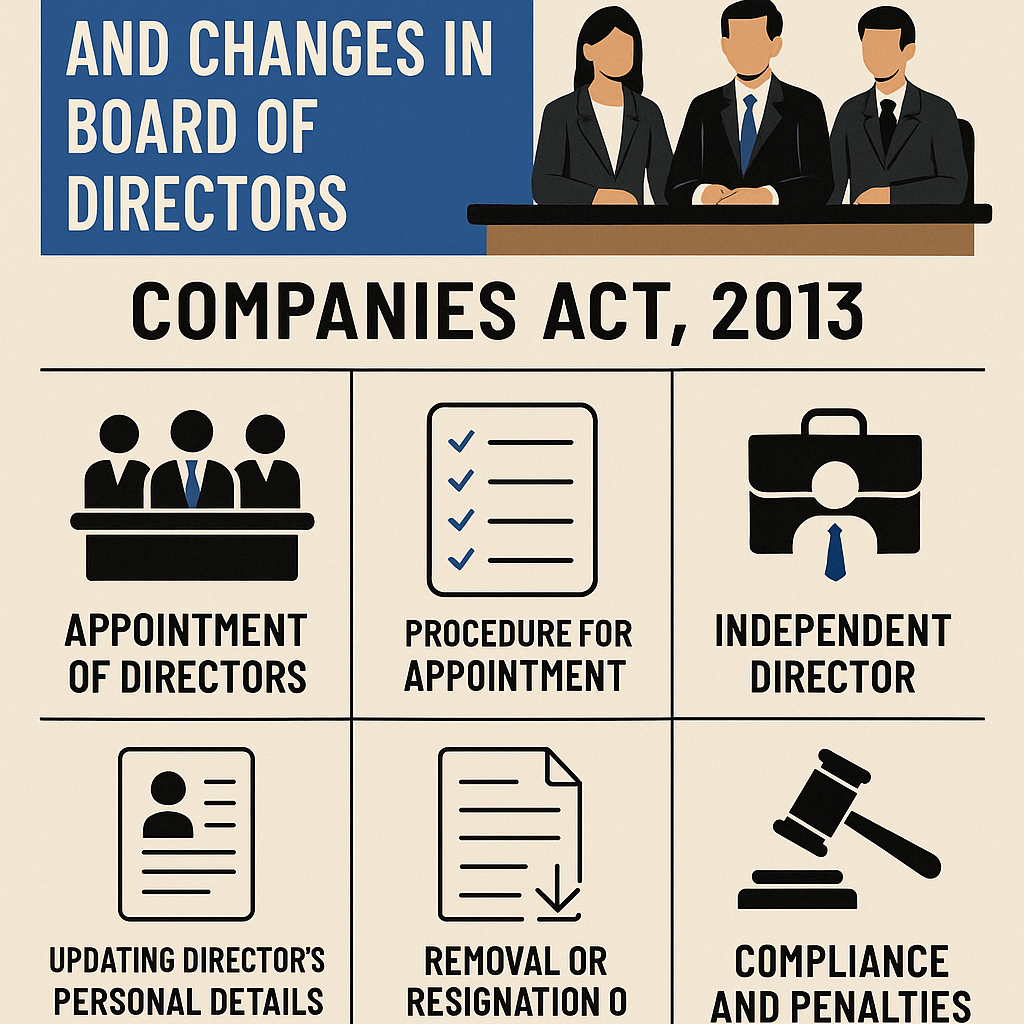As a business professional, it’s essential to have a solid understanding of the legal requirements surrounding the appointment and changes in a company’s board of directors. The Companies Act, 2013 lays out detailed guidelines that companies must adhere to when dealing with directorship matters. In this blog, we’ll explore the key aspects you need to be aware of.
Appointment of Directors:
The Companies Act mandates that a company must have a Board of Directors consisting of a minimum of three directors for public companies, two for private companies, and one for One Person Companies. Companies can appoint a maximum of fifteen directors unless they pass a special resolution to increase the limit. Additionally, every company must have at least one director who stays in India for at least 182 days during the financial year.
The process of appointing directors involves obtaining a Director Identification Number (DIN) for the proposed individual, followed by their appointment in a general meeting, unless the company’s articles state otherwise. The appointed director must provide written consent before or at the time of appointment, and the company must file the necessary forms with the Registrar within 30 days.
Procedure for appointment of Director:
| Application of DIN | MCA business user should be created from the proposed Director’s registered Email and Phone number, DIR-3 (Application for DIN) e-form should be filed for all the additional directors. |
| Form DIR-2 | Consent of director should be given to the company in Form DIR-2. |
| Notice of GM | A notice of GM should be made to all the members at least 21 days prior the GM |
| Conduct GM | An ordinary resolution (50% should vote) for appointment of director is mandatory. |
| Form MGT-14 | 1. This form should be filed with in 30days of passing the resolution. 2. Certified copy of resolution, notice of meeting, Explanatory statement, and approval of appointment should be attached to the form |
| Form DIR-12 | 1. Form DIR-12 should be filed within 30days of appointment 2. Copy of Ordinary resolution passed at GM, Form DIR-2, and letter of appointment should be attached to this form. |
| Update the Register of Directors | The company’s register should be updated. |
| Form MBP-1 | The newly appointed director should disclose his interest in other companies or firms to the board of the company in this form at the first board meeting they participate. |
| Intimation to stock exchange (Listed companies) | 1. If new appointment of director is made by a listed company a disclosure should be made to National Stock Exchange. 2. An intimation letter should be given to the stock exchange where the company’s shares are listed. 3. The intimation letter should contain: Date of board meeting in which appointment is made, Basic details of the proposed director, Nature of appointment etc., |
| Director KYC | DIR-3 KYC should be filed annually before September 30th. |

Appointment of one women director:
One crucial requirement is that at least one-woman director must be present in Every listed company or companies with a paid-up share capital of 100 crore rupees or more or a turn over of 300 crore rupees or more.
Independent Director:
Independent directors play a crucial role in ensuring corporate governance, transparency, and accountability in companies. They are expected to bring objective judgment to board deliberations and are not involved in the day-to-day management. As per the Companies Act, 2013, certain classes of public companies are required to appoint independent directors, and their appointment and removal must comply with prescribed norms.
Changes in Directors:
During a director’s tenure, there may be changes in their personal information, such as address or contact details. In such cases, the director is responsible for informing the Central Government about the changes using Form DIR-6 within 30 days. The company must also be notified of the changes within 15 days.
When a director resigns, the company must file the resignation details with the Registrar in Form DIR-12 within 30 days. The resigning director can also submit a copy of their resignation and the reasons for it in Form DIR-11.
In the event of a director’s removal, the company must follow a due process, including providing the director with a reasonable opportunity to be heard. The removal of an independent director requires a special resolution and compliance with the prescribed procedures.
It’s crucial to maintain a register of directors and key managerial personnel at the company’s registered office, which should include details such as their identification numbers, personal information, and shareholding in the company or its subsidiaries and associate companies. This register must be accessible for inspection by members and the Registrar.
Procedure for removal of directors/ resignation of director:
| Notice of Resignation | The director intending to resign should submit a written notice to the company. |
| Board meeting | 1. Board meeting must be conducted to accept the resignation 2. Board resolution should be passed in accepting the resignation of director. 3. Resignation must be recorded in the Minutes of Meeting |
| Form DIR-12 | 1. The company is required to file Form DIR-12 within 30days of receiving the resignation notice 2. A certified copy of the Board Resolution accepting the resignation, Resignation Letter from the director should be attached to the Form. |
| Updating of registrar | The company’s register should be updated about the Resignation. |
| Disclosure to Shareholder | 1. The company should update in its website about the resignation of its director. 2. For listed companies, an intimation letter should be filled with the Stock Exchange about the resignation within 24 hours of the Board Meeting as per SEBI Listing Obligations and Disclosure Requirements Regulations. |
| Annual Filling (Director’s report) | The details of director’s resignation should be mentioned in the Director’s report in the subsequent AGM. |
Compliance and Penalties:
Failure to comply with the provisions related to the appointment and changes in directors can result in penalties for both the company and the defaulting officers. The Act imposes fines ranging from fifty thousand rupees to three lakh rupees for the company, and up to one lakh rupees for the defaulting officers.
Conclusion
Managing the appointment and changes in company directors requires a thorough understanding of the legal framework and diligent compliance with the Companies Act, 2013. By staying up to date with the relevant rules and regulations, businesses can ensure a smooth and transparent directorship process, contributing to the overall governance and success of the organization.

